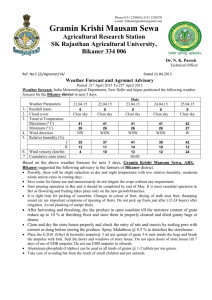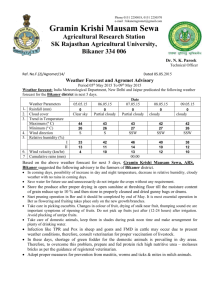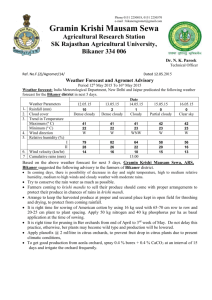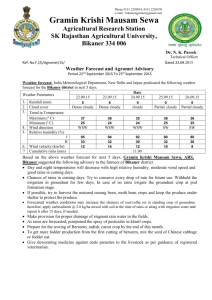Artificial Intelligence CSE 473
advertisement
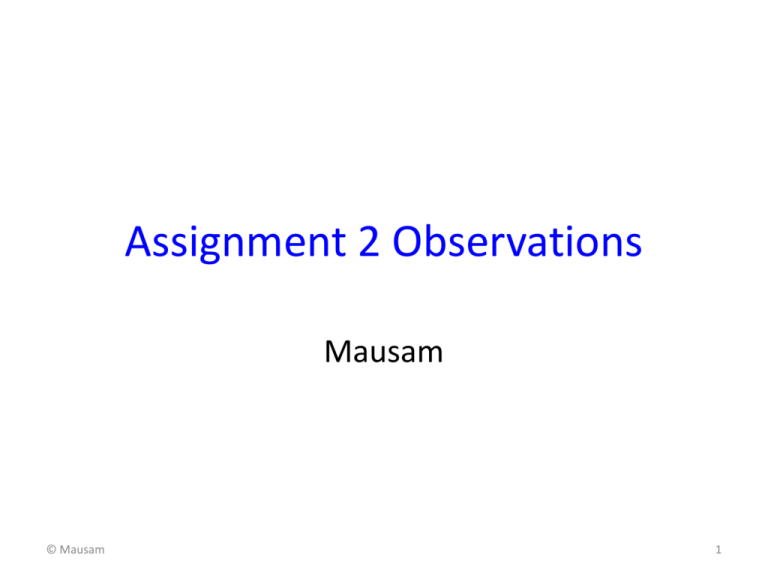
Assignment 2 Observations Mausam © Mausam 1 The SAT Encoding • Induced Subgraph Isomorphism – NP complete problem – Applications: similarities between chemical compounds; protein-interaction networks, social networks, circuit design.. • Variables – X(i,j) denotes that ith node (in smaller graph) mapped to jth node (in larger graph) – Self edge: If node i has a self-edge and node j doesn’t • remove X(i,j) – Self-edge: If node j has a self-edge and node i doesn’t • remove X(i,j) © Mausam 2 The SAT encoding • Each node maps to exactly one other node – X(i,1) X(i,2) X(i,3)… X(i,n) – Pairs of X(i,1) X(i,2); X(i,1) X(i,3) … • Each node in larger graph maps to at most one node – Pairs of X(1,j)X(2,j); X(1,j)X(3,j); … • Disallowed pairs of mappings – If edge(i1,i2) and no edge(j1,j2): X(i1,j1)X(i2,j2); – If no edge(i1,i2) and edge(j1,j2): X(i1,j1)X(i2,j2); – If edge(i1,i2) and edge(j2,j1): X(i1,j1)X(i2,j2); • Overall – O(nm) vars, O(n2m2) clauses © Mausam 3 Fun optimizations U A C B S P Yes. A mapping is: M(A) = S, M(B) = Q, M(C) = R R T The edges from P to other nodes don‘t matter since no node in G got mapped to P. Q • Degree trick: Can B ever map to P/S/R? – No: Indegree of B is greater than indegree of P/S/R – Remove X(B,P), X(B,S), X(B,R) • Common neighbor constraint: Can A-U and C-T? – – – – • … © Mausam They both don’t have an edge They both have outdegrees 1 No: because AC have common neighbor 1; UT 0 X(A,U)X(C,T) 4 Observations • People solved ~100+80 node problems… – For an NP hard problem that’s not too bad, is it? • Paresh’s observations – adding redundant clauses helps miniSAT for tough problems. © Mausam 5 Best Competitors • Kim Wallmark • Alan Ludwig • Haroon Barri © Mausam 6 Assignment 3 Discussion Mausam © Mausam 7 BlackJack: State Space • • • • • MinSum: the minimum sum of the player's hand so far. NumAces: the number of Aces in the player's hand so far. dMinSum: the minimum sum of the dealer's hand so far. dNumAces: the number of Aces in the dealer's hand so far. isTwoCards: a Boolean that represents that the player's hand has just two cards so far. • isBlackJack: a Boolean that represents that the player got a BlackJack. • pair: has value between 0 and 10. Zero indicates that the player doesn't have a pair. Any other value i indicates that the player has two cards of value i. • turn: a Boolean to indicate whether it is player's turn or dealer's. © Mausam 8 BlackJack: Action Space • Stand: Turn = 0 • Hit: get a new card with prob… update minSum, numAces, isTwoCard, pair • Double: get a new card, update minSum, numAces, etc.; – Turn = 1. – Allowed when isTwoCard = 1 • Default: run default dealer policy. – Allowed with turn = 1 • Split: tricky! – Allowed with pair > 0; isTwoCard = 1 © Mausam 9 Equations Q( s, HIT ) P( s' | s, HIT )V ( s' ) s' Q( s, STAND) P( s' | s, STAND)V ( s' ) s' Q( s, DEF ) P( s' | s, DEF )V ( s' ) s' Q( s, DOUB ) 2 P( s' | s, DOUB )V ( s' ) s' © Mausam 10 BlackJack Split (say only three cards) • (c,c) • Q((c,c), SPLIT) – [(c,1) & (c,1)] p1p1 – [(c,1) & (c,2)] p1p2 – [(c,1) & (c,3)] p1p3 – [(c,2) & (c,1)] p2p1 – [(c,2) & (c,2)] p2p2 – [(c,2) & (c,3)] p2p3 – [(c,3) & (c,1)] p3p1 – [(c,3) & (c,2)] p3p2 – [(c,3) & (c,3)] p3p3 – 2p1p1V(c,1) – p1p2V(c,1) – – – – – – – + p1p2V(c,2) p1p3V(c,1) + p1p3V(c,3) p2p1V(c,1) + p2p1V(c,2) 2p2p2V(c,2) p2p3V(c,3) + p2p3V(c,3) p1p3V(c,1) + p1p3V(c,3) p2p3V(c,3) + p2p3V(c,3) 2p3p3V(c,3) 2p1(p1+p2+p3) = 2p1 © Mausam 11 Equations Q( s, HIT ) P( s' | s, HIT )V ( s' ) s' Q( s, STAND) P( s' | s, STAND)V ( s' ) s' Q( s, DEF ) P( s' | s, DEF )V ( s' ) s' Q( s, DOUB ) 2 P( s' | s, DOUB )V ( s' ) s' Q((c, c,...), SPLIT ) 2 P(c' )V (c, c' ,...) c' © Mausam 12 Value of Terminal States • If isTwoCards = 1, minSum=11, numAces = 1 – Return 1.5 • If minSum>21 – Return -1 • If minSum < 21 and dMinSum > 21 – Return 1 • … • … © Mausam 13 Can you solve it with Expectimax? • No – Because there is possibility of infinite loop • Values are well-formed – Loop of size n becomes less probable as n increases – (see beginning example from lecture on MDPs) – EXCEPTION: Q(1010, split) for p> 0.5 • Solution: use Value Iteration/Policy Iteration © Mausam 14 Optimizations • Dealer’s policy is fixed. So, run the Markov chain ahead of time to generate a table – – – – – – • • • • Pr(dealer gets 17|first card=c) Pr(dealer gets 18|first card=c) Pr(dealer gets 19|first card=c) Pr(dealer gets 20|first card=c) Pr(dealer gets 21|first card=c) Pr(dealer busts|first card=c) Remove dMinSum, dNumAces, turn. Add dFirstCard Remove Default action Change the equations for double/stand based on computed probabilities © Mausam 15 Comments • numAces – not required. Convert to hasAce – Only first ace is relevant. After that each ace = 1 • Handle infinite splits by allowing say, 10 splits – Should work fine in practice • Modification: have the bet amount in state space – Needn’t multiply by 2 in equations for doubling – Need to use this info when computing terminal rewards © Mausam 16 Difference in solutions? • In real BJ: Dealer and player BJ is a push – In our BJ: player wins • ??? • In real BJ: there is a 4/6/8 card deck – In our BJ: infinite cards • You can easily modify code to handle 1st case – 2nd case: Monte carlo sampling! © Mausam 17 Should you play our BlackJack? • Expected reward before game starts – SUM[Pr(game)*expected reward of the game] • Deal three cards… and use V(s) to compute exp reward • My expected reward: $0.058 – Yes! We should play the game © Mausam 18 Discussion Mausam © Mausam 19 Followup Courses • 546 Machine Learning/Data Mining • 515 Probabilistic Graphical Models • 517 Natural Language Processing • ??? AI/Statistics for Big Data • 571 Robotics • 579 Intelligent control • 574 Special Topics in AI • 528 Computational Neuroscience •© Mausam 510 Human computer Interaction 20 Final Exam • 50% objective – – – – True/false Multiple choice Fill in the blanks Match the following… • 25% short answer questions – 1 word – 5 line responses… – opinions/strengths/weaknesses/etc… • 25% Problem solving – Problem modeling; short calculations… © Mausam 21 Why do an exam? • Goal: revise and analyze the whole course • Expected preparation time – ~1 day – Go over lecture slides – Read parts of the notes that are unclear… © Mausam 22 What worked • Programming Assignments – You hated them – You loved them – You learned through them • Written Assignments(?) – Forced us to be regular • Classes – I absolutely enjoyed the interaction! • Emails/bulletin boards • Videos(?) © Mausam 23 What didn’t work • Programming environment – People didn’t know unix – People didn’t know Java! • Packed – Once someone got behind, it got tough to recover • Workload © Mausam 24 Thanks • To all of you – who contributed to helping each other through newsgroup and other questions – who asked terrific questions in class – who gave regular feedback on class, assignments, grading, organization © Mausam 25
